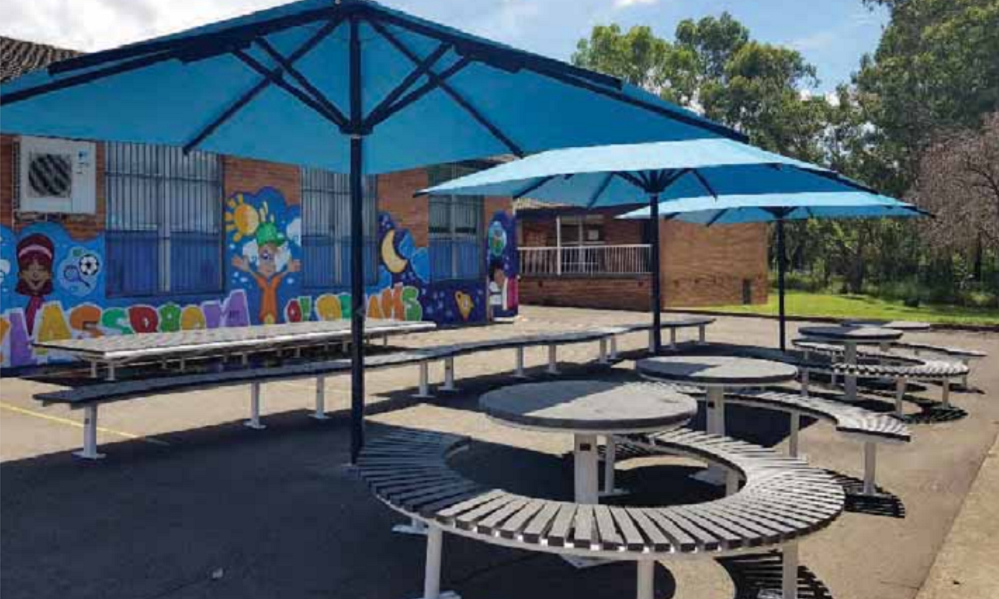Fostering a sense of school pride and meeting the individual needs of every student are just two priorities for Melanie Macmillan, Principal of Warwick Farm Public School in southwestern Sydney. In the first installment of a two-part series, Macmillan shares how she focuses on community partnerships, visible leadership and student engagement to achieve those goals.
In 2017, Melanie Macmillan was in a relieving principal position at a neighbouring school when she found out she was appointed Principal of Warwick Farm Public School. She didn't begin her new role immediately, but rather spent the next term or so planning and preparing, and getting an external insight into the new school and the wider community.
Once she commenced, from the outset Macmillan acknowledged that there were several challenges that needed to be overcome. The school has approximately 220 students enrolled across K-6. Three-quarters are from a Language Background Other Than English (LBOTE) and the school's Index of Community and Socio-Educational Advantage (ICSEA) value of 940 is lower than average, with approximately half of the student cohort (54 per cent) in the bottom quarter of socioeconomic status. In addition, the school has one of the highest mobility factors in New South Wales.
‘In 2016 it was 41 per cent and last year, for 2019, it was 37 per cent. So our last year's Year 6 kids, only 42 per cent of those kids had begun school at our school in Kindergarten – so really high mobility,' Macmillan tells Teacher.
When the student population is highly mobile, classroom numbers can change regularly. This can impact school activities, such as sports teams and group-based work, and can create a sense of uncertainty and instability for students. Macmillan identified early into her tenure that it was important to instill in students a sense of belonging and school pride.
The importance of school pride
One of the initial changes Macmillan introduced was updating the school colours and emblem, and in turn, the school uniform. She says that she didn't see this as a challenge but rather an opportunity to improve school pride and shift past perceptions of the school as being disadvantaged or outdated.
Macmillan says she was pleasantly surprised that the transition from old to new uniforms was quite seamless for students and their families.
‘We imagined for three years there would be some in the old colours and some in the new colours, and within a term, we hardly saw any yellow at all. Amazing! We did that by using equity funds, because we have such high mobility, any currently enrolled child, we gave them a $45 voucher for the store that was selling the uniform and that would give them a free hat or a free polo. Or if they contributed $5, they could get the dress and the hat. So we really supported the transition,' she explains. ‘The kids now, they look amazing!'
The school also invested heavily in its buildings and facilities to signal a visible and symbolic renewal of the school. Colourful spaces, new signage and updated buildings help to attract students to the school, and encourage them to feel happy walking through the school gates. ‘Just a lick of paint, a trip to Kmart, you know it really does a lot for the engagement of classrooms and the whole school,' Macmillan says.
The Classroom of Dreams
As a new principal, Macmillan had the unique opportunity to see the school through fresh eyes. She shares once specific example of the staff car park, which had a pedestrian crossing straight through it that connected the K-4 classrooms to the 5-6 classrooms.
‘That term where I had the opportunity to not be the principal but come and check it all out, the whole safety thing just freaked me out. But I knew that was going to be a very controversial decision [to move the staff car park] because I was asking teachers to not only change habits, but to then go and park in the mud. So it was very uncomfortable, I was scared about making that decision, even though I knew it was a safety thing, I didn't want to put staff off-side,' Macmillan shares.
The executive team decided to turn the old car park into an outdoor classroom and engaged the whole school in the project. Macmillan says Kindy kids used drawings and Lego to map out their ideas, while the Stage 3 [Year 5 and 6] students planned and designed using Minecraft. The best ideas were then selected to bring the classroom to life. They now call this space The Classroom of Dreams.
‘A group of our most needy Year 6 kids annually go to a place called the Street University in Liverpool and they designed the Classroom of Dreams mural over 10 weeks. They then actually painted on the wall for two weeks with Mistery, a street artist Chaplain through The Ted Noffs Foundation,' Macmillan shares.
She says that while she was initially uncomfortable about the safety aspects and staff reactions to this project, it turned out to be one of the most positive experiences she's had at the school.
Visible leadership
Alongside the visible transformation of the buildings and uniforms, the school executive strives to emulate ‘visible leadership' within the community.
Macmillan, and her team, are on-site at the school gates every morning to welcome students and their families – taking the opportunity to have informal conversations and passing on good news to families. ‘Every morning I'm on duty on the playground from 8.30am – welcoming families, talking with kids, doing check-ins on our students that we know have some social needs, or just talking with kids. It's great, one of the best parts of my day.'
Macmillan says these purposeful welcoming strategies are in place to make students feel that school is a safe and supportive place to be. ‘It just means that we're very approachable – we're there for any parent at any time, any child at any time, you can ask any questions, we can solve things really quickly. They tell me incidents from classrooms, parents ask how to make a payment, all of those sorts of things,' she adds.
‘It generally means that we're not only physically visible but that we're available, and that's been a huge success. Staff who were at the school before this started have commented that that's been a huge change to the visibility of the leadership.'
Macmillan says that the executive team are also encouraged to take a ‘yes' approach to everything they're asked, within reason. ‘We assume that any teacher or kid who asks us something, that they actually need it to improve the learning and we, where possible, really try hard to make any request happen.'
Connecting to the community
Warwick Farm Public School has a strong commitment to providing a wide range of learning opportunities to its students and their families. The school is located next to the Liverpool Neighbourhood Centre, which has the lease to the school canteen. The canteen upskills typically non-employed women from the centre to serve food and provide catering for school meetings and professional learning. The school also connects with many local charities – FoodBank Australia provides all the food for the school Breakfast Club, which ensures that parents and students are eating food daily.
The school also runs several parent programs like the Parents as Teachers of Children Program (PATCH), which teaches parents how to read with their child.
‘We have English classes, classes on how to get a job, how to write a CV, how to navigate through the Centrelink system for families who are refugees – heaps of things like that,' Macmillan says.
The school has an excellent relationship with the local police department's youth liaison officer, who provides life skills programs like how to build self-confidence and maintain relationships, as well as teamwork.
‘We also work really closely with South West Connect, again with other charities that provide unbelievable experiences for us. One was called the Educational Aspirational Tour and so they take the kids, all paid for, on a tour of Sydney. They go to Sydney Uni, they go to UTS (University of Technology Sydney) they go to the State Library – all of these very academic, educational facilities, which our kids may not get the opportunity to visit,' Macmillan shares.
Keeping students busy and engaged
Macmillan believes that keeping students busy is the first step in maintaining their engagement with school life. She says that when she thinks back on that first term of 2017, she was just overwhelmed by the general non-compliance and behaviours they were displaying in classrooms and on the playground.
‘The school didn't have consistent practices so we picked up the Positive Behaviour for Learning Program and we made everything consistent. We've got nice, clear expectations, high expectations of behaviours, in classrooms and on the playgrounds. But I think that a huge part of our success in the number of behaviour incidents (which have completely decreased) is keeping them busy,' Macmillan says.
For example, older students are able to apply to be ‘principal/administrative officer/general assistants for a day' to provide opportunities for work experience. In addition, the school engaged a Student Wellbeing Support Officer, Josh, who works with the kids to build resilience and teaches them to get over problems in a positive way. The school also hired a Student Engagement Officer, Lucas, who plays with kids on the playground before school, during recess and lunch, three days a week. Lucas plays NRL at a Jersey Flegg level and works to teach students the importance of balancing sport and other extracurricular interests with academic and educational outcomes.
Supporting staff wellbeing
While many of the wellbeing programs have been established to support students and their learning, Macmillan says there are also things several things they do to support staff in the work they do. Symbolically, each term, they hold a Wellbeing Week for staff where no meetings are held and staff are encouraged to come to school on time and leave by 4 pm.
‘I ask staff to really prioritise doing something different to be able to look after themselves. It might be getting your hair done, going to the movies, whatever it is … I don't mind what it is but really having quality time away from doing all the extra things that we have to do at school,' Macmillan says.
The school executive also plans something free and fun for staff each day. ‘On Monday we had the unveiling of a table tennis table, so in a professional learning room, there's a table tennis table there and there's a big tournament that's going on between staff and that's been really fun. And on Tuesday we had Tuesday Treats – so there were mini-Magnums that were handed out to all staff at the end of the day.
‘It's the symbolic gesture of: we appreciate you, we understand how much hard work you do and thank you so much for everything you do. It has been a huge change and helped to create a really healthy, sustainable school culture,' Macmillan says.
One other way they show support to staff is by gifting them with lesson plans for Christmas each year. Macmillan says they're given to staff on a USB and include everything that is needed to get through the first three weeks of the following school year. The whole idea is to ensure that staff aren't spending their Christmas break preparing new units or putting resources together.
‘Everything is ready to go for them to be able to work from, so they don't need to spend unnecessary time doing things, they don't need to recreate the wheel every year. And we gift that, we wrap that up as a Christmas present with Christmas ribbon and it's all lovely,' Macmillan says.
Stay tuned: In tomorrow's article Melanie Macmillan shares how she's further developed her leadership skills by taking part in the Leadership for School Excellence program course at the Harvard Graduate School of Education.
As a teacher, how do you work to instill a sense of school pride in your students? What impact does this have on their engagement, both in the classroom and in the wider school community?
As a school leader, how do you show support and gratitude to staff for the work they do? Is this something that you do regularly? What is the overall reaction from staff?
You can find out more about the Warwick Farm Public School and how high expectations drive student learning in this case study from the New South Wales Centre for Education Statistics and Evaluation.



